Introduction
Austin, Texas, often referred to as the “Live Music Capital of the World,” is a vibrant and rapidly growing city that attracts visitors from around the globe.
With its booming tech industry, renowned festivals, and cultural attractions, it’s no wonder that the short-term rental market in Austin has experienced significant growth in recent years. In this blog post, we’ll delve into the key statistics and trends of the short-term rental market in Austin, providing valuable insights for both potential investors and travelers.
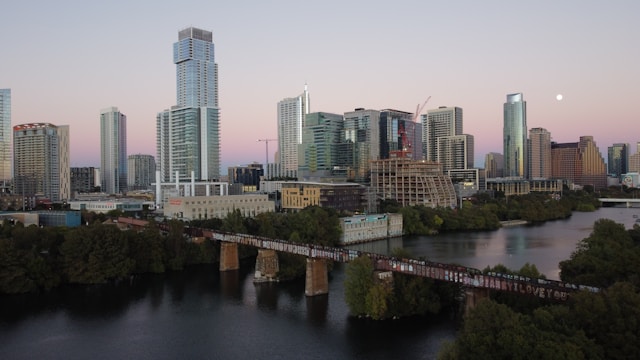
Market Overview
To understand the dynamics of the short-term rental market in Austin, let’s delve into some key statistics and figures.
Supply
The most popular homes are 3-bedroom homes, comprising 23.94% of inventory. This is followed by 1 and 2-bedroom homes at 22.96% and 19.22% of the total inventory, respectively.

Homes Appreciation
AS of July 2025, according to Zillow, homes in Austin experienced an depreciation of -4.02. This data indicates a significant decrease in property values.
Median Home Value
As of January of 2025, Homes in Austin have depreciated by -4.02%. The median home value in Austin is $513,622 as reported by Zillow. This figure highlights the city’s robust real estate market and the potential for long-term property appreciation.
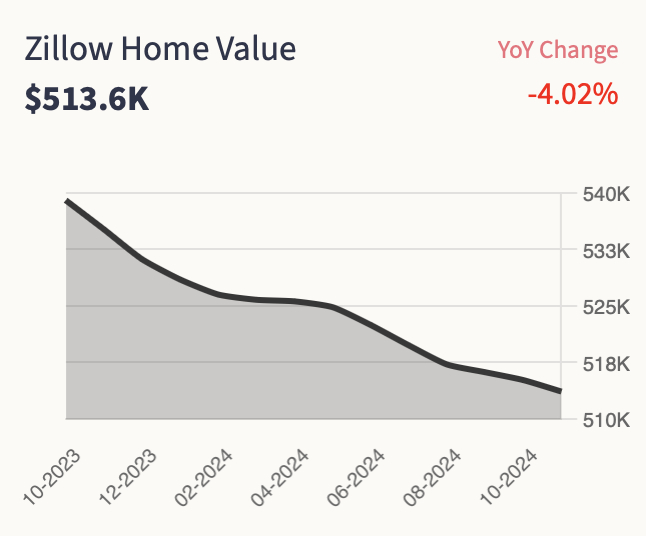
Active Short Term Rentals
AS of July 2025, Austin boasts a significant Airbnb rental market, with approximately 10,280 active rentals. This abundance of available properties provides ample opportunities for investors and homeowners looking to capitalize on the tourism demand.
Average Daily Rate
The median ADR for the market is $269.51. The Average Daily Rate is the highest for 5 bedroom homes ($519) followed by 4-bedrooms and 3 bedrooms at $460 and $386 respectively.
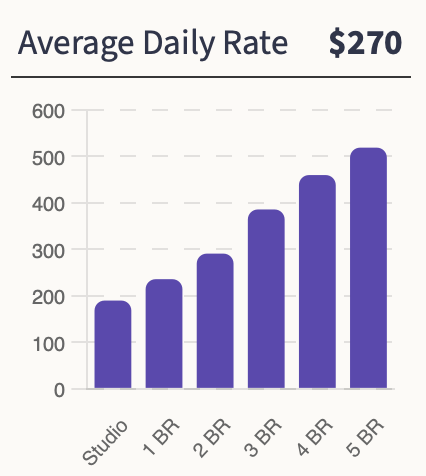
Occupancy Rate
Chalet data reveals an occupancy rate of 56% for Airbnb rentals in Austin. This high demand ensures a consistent stream of income for property owners and investors.
How Profitable is Airbnb in Austin ?
AS of July 2025, the average gross yield, which represents the annual income generated by a property as a percentage of its value, is 8.15% in Austin. This figure suggests that short-term rentals in the city offer a favorable return on investment. Austin is ranked #79 by return on investment on Airbnb rentals in the United States.
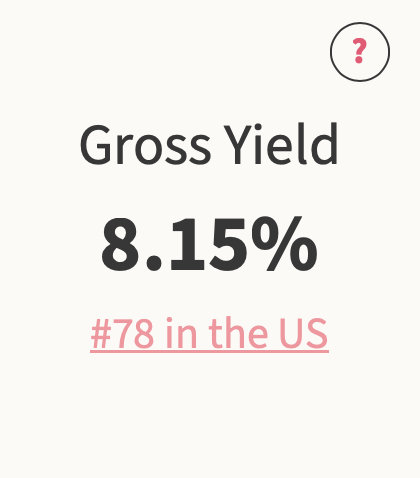
Annual Revenue
According to Chalet, short-term rentals in Austin earn an average of $41,887 annually, highlighting the strong investment potential in the city’s market. You can evaluate your properties using our free Airbnb calculator.
Property Tax
According to SmartAsset, the average property tax in Austin is 1.77%. This relatively moderate tax rate is an important consideration for those looking to invest in short-term rental properties.
Top 100 Airbnb Rental Markets

Instantly compare the top 100 short-term (Airbnb) rental markets in the US
Regulations
Austin;s short-term rental regulations are somewhat investor-friendly, with different zoning regulations and limitations in place. Understanding these regulations is crucial for potential investors to ensure compliance and a smooth operation.
Hosts
The market is dominated by property management firms. The largest host is Vacasa Texas with 4.56% of the total inventory and an average review of 4.80⭐️s .
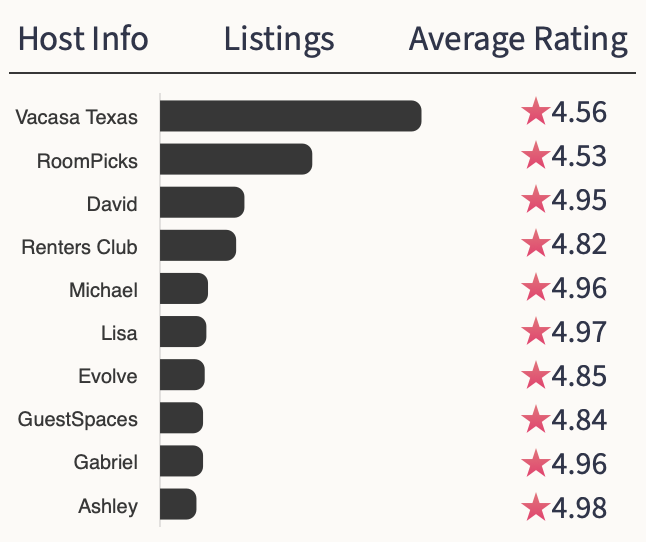
Key Questions
Now, let’s address some of the key questions that provide additional context about Austin, TX, and its short-term rental market.
Median Household Income
The median household income in Austin, TX is an essential indicator of the purchasing power and economic conditions of the city’s residents. As of 2021, the median household income in Austin was approximately $78,800.
Climate
Austin experiences a subtropical climate, characterized by hot summers and mild winters. Summers are typically hot and humid, with temperatures often reaching the high 90s Fahrenheit (around 35-38 degrees Celsius). Winters are generally mild, with temperatures averaging in the 60s Fahrenheit (around 15-20 degrees Celsius).
Guests
The majority of the guests come from inside of Texas. 8.70% of all guests are from Austin followed by Houston with 8.41%.
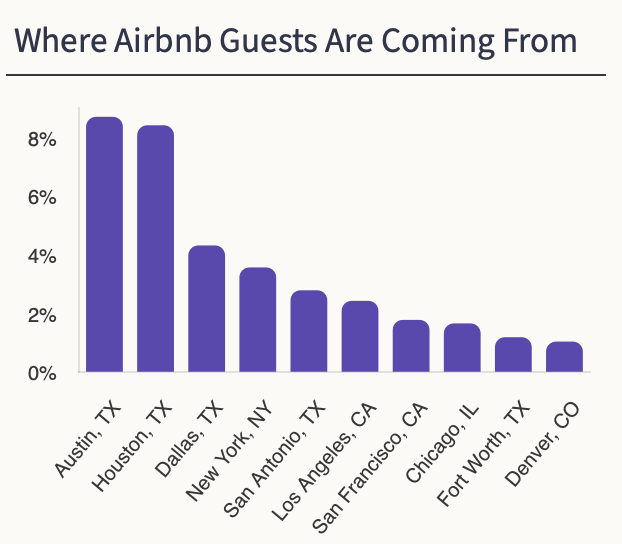
Population Size
As of 2021, the estimated population of Austin, TX was around 1 million residents. The city’s population has been steadily increasing over the years, driven by factors such as job opportunities, quality of life, and cultural attractions.
Sports Teams
Austin is home to several professional sports teams, including the Austin FC, a Major League Soccer (MLS) team that began playing in 2021. The team’s presence has added to the city’s vibrant sports culture, offering exciting matches and events for sports enthusiasts.
Colleges and Universities
Austin boasts a robust education sector and is renowned for its prestigious universities. The city is home to the University of Texas at Austin, one of the largest and most respected public research universities in the United States. Additionally, Austin is home to other institutions such as St. Edward’s University, Concordia University Texas, and Huston-Tillotson University.
Crime Rate
It’s important to consider the safety and security of a city when analyzing the short-term rental market. Austin’s crime rate is relatively low compared to other major cities in the United States. However, it’s always advisable to exercise caution and take necessary precautions as a traveler or property owner.
Visitor Demographics and Total Number of Visitors
Austin attracts visitors from various parts of the world. While specific data on visitor demographics and the total number of visitors may vary, the city welcomes a diverse range of travelers, including domestic and international tourists, business travelers, and those attending festivals and events.
Popular Tourist Attractions
Austin offers a wealth of tourist attractions that contribute to its popularity as a travel destination. Some of the city’s top attractions include:
- Texas State Capitol: A stunning architectural masterpiece and the seat of the Texas government.
- Lady Bird Lake: A picturesque reservoir offering opportunities for outdoor activities such as kayaking, paddleboarding, and hiking.
- Barton Springs Pool: A natural spring-fed pool located in Zilker Park, perfect for swimming and relaxation.
- South Congress Avenue: A vibrant street lined with unique shops, boutiques, and renowned eateries.
- The University of Texas at Austin: A campus known for its beautiful architecture, museums, and cultural events.
Peak Season
Austin experiences a peak tourist season during the spring and fall months. Spring, especially March, brings an influx of visitors who come to enjoy events like the South by Southwest (SXSW) festival and the Austin City Limits Music Festival. Fall is another popular time to visit, with pleasant weather and various cultural and music festivals taking place.
Conclusion
The short-term rental market in Austin, TX presents a promising opportunity for property owners and investors seeking to capitalize on the city’s growing tourism industry. With a significant number of active rentals, attractive revenue potential, and a somewhat investor-friendly regulatory environment, Austin offers a favorable market for short-term rental ventures.
However, it’s essential to consider factors such as home values, property taxes, and market dynamics before making investment decisions. Additionally, understanding the city’s demographics, climate, attractions, and peak seasons can help both hosts and travelers make the most of their experiences in the vibrant city of Austin.

